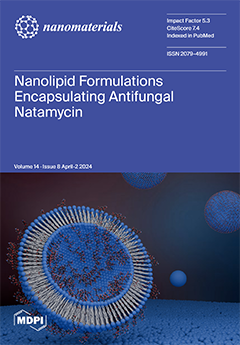Nitrite monitoring serves as a fundamental practice for protecting public health, preserving environmental quality, ensuring food safety, maintaining industrial safety standards, and optimizing agricultural practices. Although many nitrite sensing methods have been recently developed, the quantification of nitrite remains challenging due to sensitivity
[...] Read more.
Nitrite monitoring serves as a fundamental practice for protecting public health, preserving environmental quality, ensuring food safety, maintaining industrial safety standards, and optimizing agricultural practices. Although many nitrite sensing methods have been recently developed, the quantification of nitrite remains challenging due to sensitivity and selectivity limitations. In this context, we present the fabrication of enzymeless iron oxide nanoparticle-modified zinc oxide nanorod (α-Fe
2O
3-ZnO NR) hybrid nanostructure-based nitrite sensor fabrication. The α-Fe
2O
3-ZnO NR hybrid nanostructure was synthesized using a two-step hydrothermal method and characterized in detail utilizing x-ray diffraction (XRD), field emission scanning electron microscopy (FESEM), transmission electron microscopy (TEM), and X-ray photoelectron spectroscopy (XPS). These analyses confirm the successful synthesis of an α-Fe
2O
3-ZnO NR hybrid nanostructure, highlighting its morphology, purity, crystallinity, and elemental constituents. The α-Fe
2O
3-ZnO NR hybrid nanostructure was used to modify the SPCE (screen-printed carbon electrode) for enzymeless nitrite sensor fabrication. The voltammetric methods (i.e., cyclic voltammetry (CV) and differential pulse voltammetry (DPV)) were employed to explore the electrochemical characteristics of α-Fe
2O
3-ZnO NR/SPCE sensors for nitrite. Upon examination of the sensor’s electrochemical behavior across a range of nitrite concentrations (0 to 500 µM), it is evident that the α-Fe
2O
3-ZnO NR hybrid nanostructure shows an increased response with increasing nitrite concentration. The sensor demonstrates a linear response to nitrite concentrations up to 400 µM, a remarkable sensitivity of 18.10 µA µM
−1 cm
−2, and a notably low detection threshold of 0.16 µM. Furthermore, its exceptional selectivity, stability, and reproducibility make it an ideal tool for accurately measuring nitrite levels in serum, yielding reliable outcomes. This advancement heralds a significant step forward in the field of environmental monitoring, offering a potent solution for the precise assessment of nitrite pollution.
Full article






